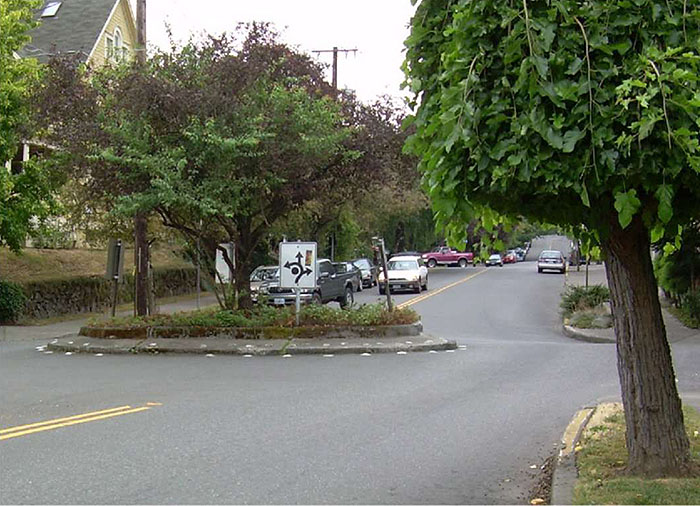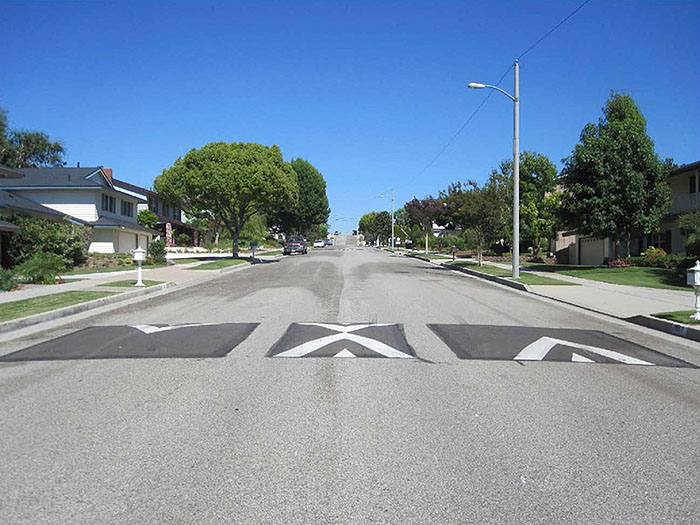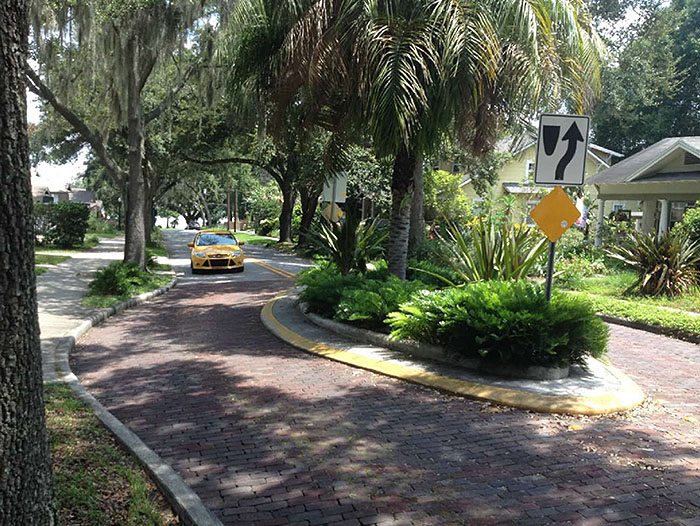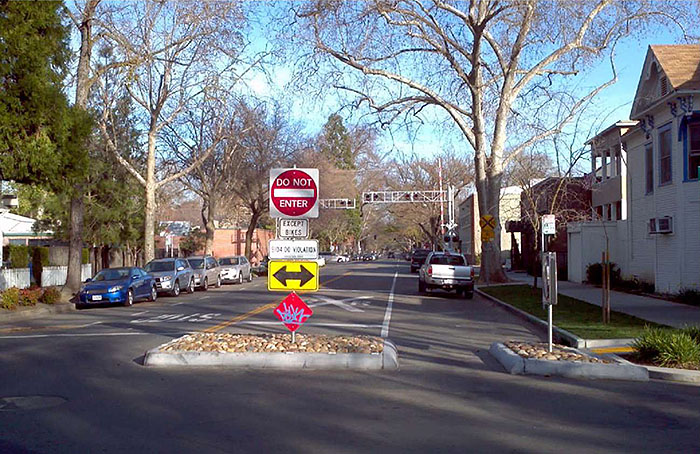U.S. Department of Transportation
Federal Highway Administration
1200 New Jersey Avenue, SE
Washington, DC 20590
202-366-4000
The Federal Highway Administration (FHWA) and the Institute of Transportation Engineers (ITE) have collaborated to produce this Traffic Calming ePrimer. It documents the results of several decades of traffic calming experience in the U.S.
This ePrimer was produced by FHWA and ITE to meet the standards of both organizations. Information in the ePrimer has been reviewed and vetted by planners, engineers, and fire officials, among others.
This ePrimer is a free, online resource openly available for public use. Providing this ePrimer for free encourages further discussion of the use of traffic calming as one tool to increase the quality of life in urban, suburban, and rural areas by reducing automobile speeds and traffic volumes on neighborhood streets.
This ePrimer presents a thorough review of current traffic calming practice and contains the information needed to understand this complex field. This ePrimer builds upon information in Traffic Calming: State of the Practice (1999), the U.S. Traffic Calming Manual (2009), and numerous references and resources (described later in sections 2.6 and 2.7).
[The ePrimer does not constitute a standard, specification, or regulation. It does not create or confer any rights for or on any person or operate to bind the public. Images in the report are intended to serve as examples of the range of real world existing conditions. The images are not limited to best practices or approved designs and in some cases may reflect conditions that are not recommended.]
For this ePrimer, traffic calming measures are grouped within four categories: horizontal deflection, vertical deflection, street width reduction, and routing restriction. The category descriptions and the measures they include are presented below.
A horizontal deflection hinders the ability of a motorist to drive in a straight line by creating a horizontal shift in the roadway. This shift forces a motorist to slow the vehicle in order to comfortably navigate the measure. The types of horizontal deflections described in this ePrimer are:

Figure 1.1. Horizontal Deflection Measure - Traffic Circle
A vertical deflection creates a change in the height of the roadway that forces a motorist to slow down in order to maintain an acceptable level of comfort. The types of vertical deflections described in this ePrimer are:

Figure 1.2. Vertical Deflection Measure – Speed Cushion
(Source: Jeff Gulden)
A street width reduction narrows the width of a vehicle travel lane. As a result, a motorist slows the vehicle in order to maintain an acceptable level of comfort and safety. The measure can also reduce the distance a pedestrian walks to cross a street, reducing exposure to pedestrian/vehicle conflicts. The types of street width reductions included in this ePrimer are:

Figure 1.3. Street Width Reduction Measure - Median Island
(Source: Ken Sides)
A routing restriction prevents particular vehicle movements at an intersection and is intended to eliminate some portions of cut-through traffic. The types of routing restrictions described in this ePrimer are:

Figure 1.4. Routing Restriction Measure - Half Closure
(Source: Jeff Gulden)
The measures covered in this ePrimer are commonly used with the express purpose of supporting the livability and vitality of a residential or commercial area through an improvement in non-motorist safety, mobility, and comfort. Only measures that are self-enforcing and for which long-standing benefits have been measured are included.
A variety of other measures have been part of traffic calming installations in jurisdictions throughout the United States. These measures are not included in this ePrimer for a variety of reasons, including:
The excluded measures include:
Although this ePrimer focuses on mostly physical measures to calm traffic, non-physical measures can also be an effective part of traffic calming. For example, educational and enforcement efforts have long been used as part of a neighborhood traffic calming program and should continue to be considered as either supplements to self-enforcing physical means or as a precursor to physical measures. The application examples presented in Module 8 include a variety of education and enforcement techniques that have been used.
The terminology used to describe various aspects of traffic calming can vary. Unlike other aspects of traffic engineering, where a slight variance in a term can change the entire meaning, traffic calming has been known to use multiple terms interchangeably. This ePrimer does not intend to force upon readers one terminology over another, as it is understood that agencies may prefer different terms. However, for consistency across this ePrimer, the following traffic calming-specific terms are used:
The ePrimer is presented in eight distinct modules (including this introduction) developed to allow the reader to move between each to find the desired information, without a cover-to-cover reading. Summaries of the modules are presented below.
This module presents a definition of traffic calming, the purpose of traffic calming, and the relationship of traffic calming to other transportation initiatives (like complete streets and context sensitive solutions).
Descriptions of individual traffic calming measures are included in this module. Planners, engineers, decision makers, and residents can use this information when developing traffic calming plans. For each device, a description, general cost, factors to consider for its appropriate application, effects and issues to consider, and design and installation specifics are presented.
Results from research on the effects of traffic calming measures on motor vehicle speed and volume are presented in this module. The information can be used to supplement individual traffic calming measure discussions in Module 3.
Traffic calming can affect all roadway users, including non-personal passenger vehicles. This module discusses the impacts that traffic calming measures can have on other roadway users, such as emergency response (fire, police, and ambulance services), public transit, and waste collection vehicles. Snow removal issues associated with traffic calming are also discussed.
Non-motorized users (e.g., bicyclists, pedestrians, persons in wheelchairs) can be affected by traffic calming. Accommodations for non-motorized users in traffic calming are discussed in this module.
This module provides examples and case studies of both comprehensive neighborhood traffic calming programs and neighborhood-specific traffic calming plans. Detail is provided on many aspects of development of a program and plans, with specifics on traffic calming warrants/criteria, top-down (data-driven) or bottom-up (application-driven)
approaches, packaging of complementary measures, design fatal flaws, and funding, among others. In addition, the module contains a section devoted to the legal authority and liability issues associated with traffic calming.
This module presents five case studies that cover both (1) effective processes used to plan and define a local traffic calming program or project and (2) assessments of the effects of individual and series of traffic calming measures
